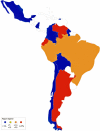Prevalence of strongyloidiasis in Latin America: a systematic review of the literature
- PMID: 24990510
- PMCID: PMC9507070
- DOI: 10.1017/S0950268814001563
Prevalence of strongyloidiasis in Latin America: a systematic review of the literature
Abstract
Strongyloides stercoralis is rarely recognized as a major public health issue, probably because its burden is largely underestimated. We reviewed the literature (both PubMed and 'grey' literature) about the prevalence of strongyloidiasis in Latin America, an area of presumable high endemicity. There were finally 88 papers involved in the analysis, covering the period between 1981 and 2011. Studies were heterogeneous in several aspects, such as the populations screened and the diagnostic methods used. Most of the studies relied on direct coproparasitological examination, which has low sensitivity for the detection of S. stercoralis larvae. The following countries presented areas of high prevalence (>20%): Argentina, Ecuador, Venezuela, Peru and Brazil. Globally, for most of the included countries it was not possible to define reliable data because of paucity and/or inadequacy of studies. S. stercoralis requires specific diagnostic methods for its detection; therefore, surveys should be specifically designed in order to avoid underestimation of the infection.
Keywords: Latin America; Strongyloides stercoralis; prevalence; review.
Figures
References
-
- Genta RM. Global prevalence of strongyloidiasis: critical review with epidemiologic insights into the prevention of disseminated disease. Reviews of Infectious Diseases 1989; 11: 755–767. - PubMed
-
- COHEMI (www.cohemi-project.eu).
Publication types
MeSH terms
LinkOut - more resources
Full Text Sources
Other Literature Sources



